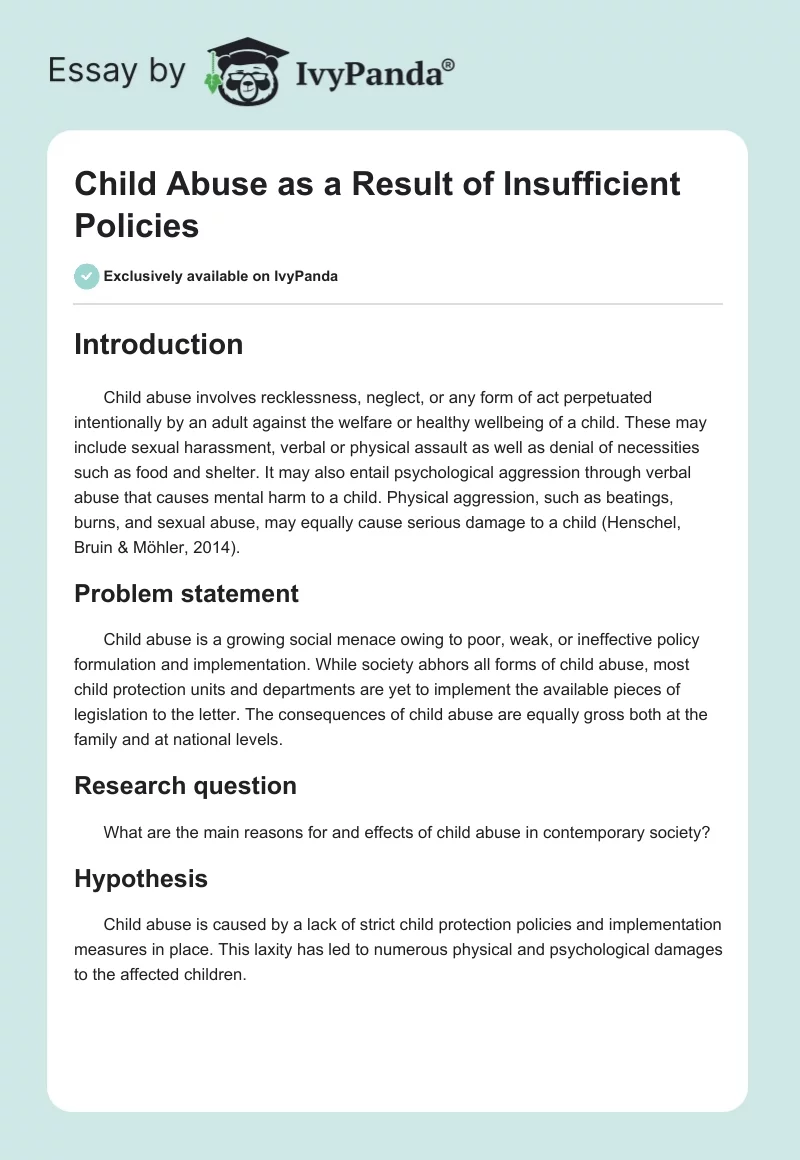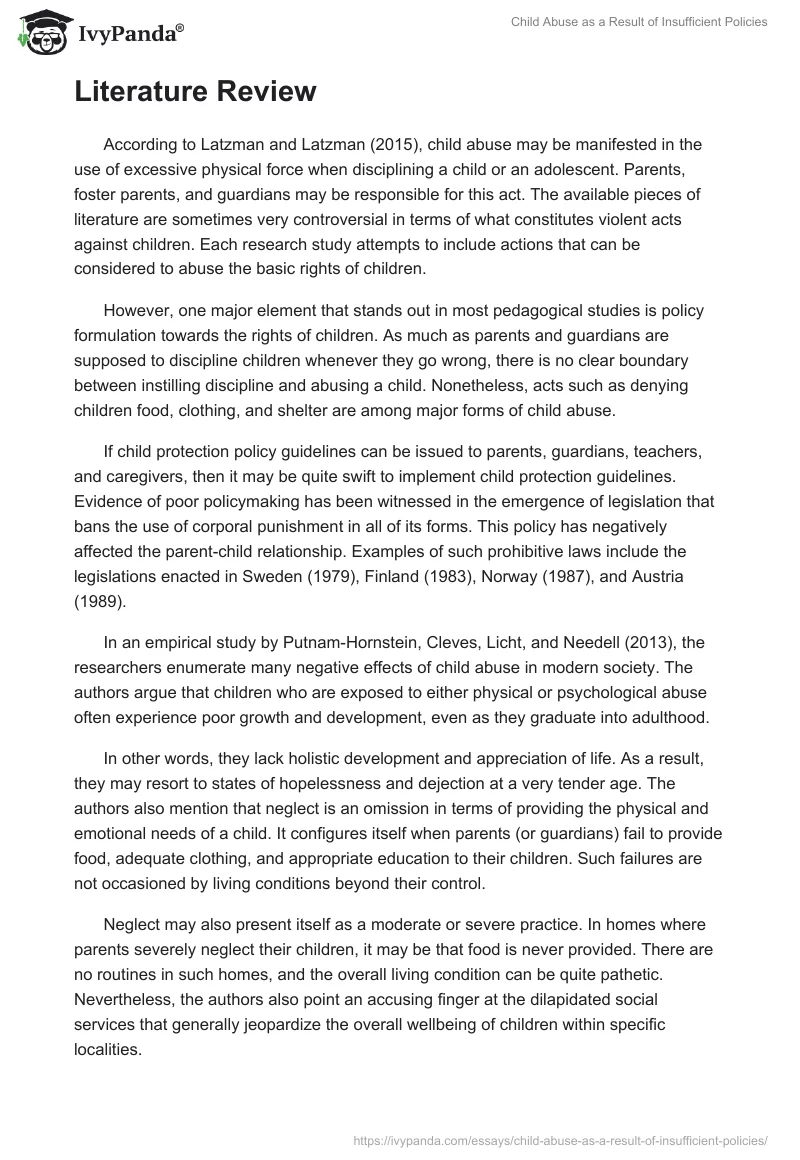Introduction
Child abuse involves recklessness, neglect, or any form of act perpetuated intentionally by an adult against the welfare or healthy wellbeing of a child. These may include sexual harassment, verbal or physical assault as well as denial of necessities such as food and shelter. It may also entail psychological aggression through verbal abuse that causes mental harm to a child. Physical aggression, such as beatings, burns, and sexual abuse, may equally cause serious damage to a child (Henschel, Bruin & Möhler, 2014).
Problem statement
Child abuse is a growing social menace owing to poor, weak, or ineffective policy formulation and implementation. While society abhors all forms of child abuse, most child protection units and departments are yet to implement the available pieces of legislation to the letter. The consequences of child abuse are equally gross both at the family and at national levels.
Research question
What are the main reasons for and effects of child abuse in contemporary society?
Hypothesis
Child abuse is caused by a lack of strict child protection policies and implementation measures in place. This laxity has led to numerous physical and psychological damages to the affected children.
Literature Review
According to Latzman and Latzman (2015), child abuse may be manifested in the use of excessive physical force when disciplining a child or an adolescent. Parents, foster parents, and guardians may be responsible for this act. The available pieces of literature are sometimes very controversial in terms of what constitutes violent acts against children. Each research study attempts to include actions that can be considered to abuse the basic rights of children.
However, one major element that stands out in most pedagogical studies is policy formulation towards the rights of children. As much as parents and guardians are supposed to discipline children whenever they go wrong, there is no clear boundary between instilling discipline and abusing a child. Nonetheless, acts such as denying children food, clothing, and shelter are among major forms of child abuse.
If child protection policy guidelines can be issued to parents, guardians, teachers, and caregivers, then it may be quite swift to implement child protection guidelines. Evidence of poor policymaking has been witnessed in the emergence of legislation that bans the use of corporal punishment in all of its forms. This policy has negatively affected the parent-child relationship. Examples of such prohibitive laws include the legislations enacted in Sweden (1979), Finland (1983), Norway (1987), and Austria (1989).
In an empirical study by Putnam-Hornstein, Cleves, Licht, and Needell (2013), the researchers enumerate many negative effects of child abuse in modern society. The authors argue that children who are exposed to either physical or psychological abuse often experience poor growth and development, even as they graduate into adulthood.
In other words, they lack holistic development and appreciation of life. As a result, they may resort to states of hopelessness and dejection at a very tender age. The authors also mention that neglect is an omission in terms of providing the physical and emotional needs of a child. It configures itself when parents (or guardians) fail to provide food, adequate clothing, and appropriate education to their children. Such failures are not occasioned by living conditions beyond their control.
Neglect may also present itself as a moderate or severe practice. In homes where parents severely neglect their children, it may be that food is never provided. There are no routines in such homes, and the overall living condition can be quite pathetic. Nevertheless, the authors also point an accusing finger at the dilapidated social services that generally jeopardize the overall wellbeing of children within specific localities.
If the local government authorities can provide the much-needed amenities for children, then quite a large number of child neglect cases can be minimized. This peer-reviewed journal article will provide invaluable information regarding child abuse that emanates from families and immediate communities.
In regards to the roles played by public health in alleviating instances of child abuse, Loc (2014) asserts that preventing child maltreatment requires a thorough input by public health officers. In fact, these officers are directly responsible for assessing emerging cases of child abuse at the local level.
Even if effective laws and child protection legislations are enacted at the top policymaking level, the desired results cannot be realized owing to poor implementation. This empirical research study will assist in linking data interoperability and child abuse at the community level and subsequently examine some of the key causes of child maltreatment.
Limitations
One of the main setbacks of this study is that the random selection of participants will not be possible. The targeted population for this research study will not work well with the random selection method. Besides, the sample population for the study will be restricted within a small geographical area. Findings from other regions will not be obtained and analyzed owing to this restriction. Hence, a small number of respondents will take part in the research study.
Methodology
Target sample
The targeted sample will comprise about 40 individuals from New York City. The entire body of data will be provided by participants from a restricted sample. The latter will be made up of households with children who have dropped out of schools or those who are confined in correction centres as juvenile offenders.
Research design and Sampling Procedures
A grounded theory methodology will be used in this research study. The main benefit or positive attribute of this theory is that it offers a comprehensive and systematic platform for conducting a research study both in its empirical and qualitative form. Besides, systematic data collection can be used to verify the grounded theory methodology.
On the other hand, this methodology is not suitable for gathering raw data from the field. Therefore, it will be supported by other relevant methods in the course of conducting the study. By using this theory, the researcher aims to verify, create rigor, enhance precision, and improve reproducibility in the entire research study on child abuse. The latter are some of the key elements of good scientific research.
The researcher also plans to use a cross-sectional study design in this research paper. The structure of a cross-sectional study that will be used is similar to that of a cohort study. However, the cross-sectional study will make use of measurements made in a single scenario of child abuse. Therefore, follow-up of individuals will be done during the study.
In order to carry out a cross-sectional study, the researcher will first set the question to be answered and then define the population to study. Finally, the researcher will define the phenomena to study and methods of measuring variables of interest. This study design is very comprehensive, even though it consumes a lot of time.
A cross-sectional study is appropriate in describing characteristics of a given population with respect to certain variables and their distribution patterns. This type of study design can also be used to describe associations between variables. In this case, the definition of independent and dependent variables depends on the causal hypothesis established by the investigator and not the actual study design.
Through the cross-sectional study, it will be possible to establish an association between child abuse and the prevalence of weak policymaking. Idiographic interviews will be conducted by the researcher using a qualitative interview technique. This design will assist in exploring helpful interventions for minors subjected to neglect and abuse.
The main advantage of cross-sectional studies is the ability and readiness to draw conclusions throughout the follow-up period. The latter enhances the rapid research design even if the process is time-consuming. This study design is also affordable, logistically easier, and not susceptible to challenges such as follow-up losses and other limitations witnessed in longitudinal studies. This study design offers the best way of monitoring and evaluating factors that cause child abuse. It is also suitable for analyzing causal networks.
Cross-sectional studies can be carried out as the first step of a cohort study or clinical trial without high additional costs. The results define the clinical and demographic characteristics of the study sample and can sometimes reveal associations of interest in the remainder of a given study.
Nevertheless, the main disadvantage of the cross-sectional study design is the inability to establish causal relationships. Hence, it cannot prove the existence of a temporal sequence between exposure factors of child abuse and the subsequent development input of policy guidelines.
This design is impractical in the study of child abuse cases in regions isolated from children. Since cross-sectional studies can only measure prevalence and not incidence, information produced by this type of study is limited because it does not go into details of child abuse.
Data collection procedures
Both document analysis and semi-structured interviews will be used to collect data in this research study. The original sample group will be used to collect the required data. In order to realize the best results during the data collection procedure, a cyclical process will be applied. The primary method of collecting data will be semi-structured interviews. The tape recording of the interviews will be carried out to allow future reference during the analysis stage.
In order to gather the largest amount of data regarding child abuse, structured interviews will be used in the initial round. In addition, the data gathering process will be guided by the above research question. Once the data analysis process has begun, the determination of subsequent interviews will be swift both in terms of content and structure. During the period, a piloting session will be carried out to refine the methods used to collect raw data.
The researcher will also seek the approval of ethics from local administration offices before beginning the data collection process. A voluntary basis will be used to obtain the respondents for the study. Informed consent will also be presented to the respondents in the study. Both the anonymity of participants and the confidentiality of the data will be treated with caution during the entire study.
Measures/variables
Logical validity will be used to measure the required outcomes of the research study. Content validity will also be instrumental in measuring whether variables such as causes of child abuse and policymaking have been adequately tackled in the research study. The effectiveness of the research design and quality of the results will be improved through the process of operationalization. The construct validity will also be crucial in this study because it will measure cases of child abuse that cannot be identified by the researcher.
References
Henschel, S., Bruin, M., & Möhler, E. (2014). Self-Control and Child Abuse Potential in Mothers with an Abuse History and Their Preschool Children. Journal of Child & Family Studies, 23(5), 824-836.
Latzman, N., & Latzman, R. (2015). Exploring the Link between Child Sexual Abuse and Sexually Intrusive Behaviors: The Moderating Role of Caregiver Discipline Strategy. Journal of Child & Family Studies, 24(2), 480-490.
Loc H., N. (2014). A Public Health Response to Data Interoperability to Prevent Child Maltreatment. American Journal of Public Health, 104(11), 2043-2048.
Putnam-Hornstein, E., Cleves, M. A., Licht, R., & Needell, B. (2013). Risk of Fatal Injury in Young Children Following Abuse Allegations: Evidence from a Prospective, Population- Based Study. American Journal Of Public Health, 103(10), e39-e44.


